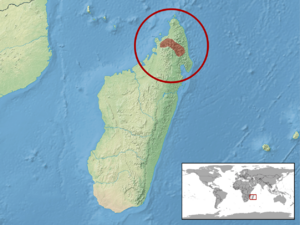Blanc's leaf chameleon facts for kids
Quick facts for kids Blanc's leaf chameleon |
|
|---|---|
| Conservation status | |
| Scientific classification | |
| Genus: |
Brookesia
|
| Species: |
betschi
|
 |
|
The Blanc's leaf chameleon, also called the Marojejy leaf chameleon, is a tiny lizard. It belongs to the chameleon family. This special chameleon lives only on the island of Madagascar. It is known for blending in with its surroundings, like leaves on the forest floor.
Contents
About the Blanc's Leaf Chameleon
Who Discovered It?
Scientists Édouard-Raoul Brygoo, Charles Pierre Blanc, and Charles Antoine Domergue first described this chameleon in 1974. They found the first one in 1973. It was in a forest in Marojejy National Park at about 1,300 meters (4,265 feet) high.
Where Does Its Name Come From?
The second part of its scientific name, betschi, honors a French biologist. His name was Jean-Marie Betsch.
Where Does It Live?
The Blanc's leaf chameleon lives in the forests of northern Madagascar. It prefers places that are between 1,150 to 1,650 meters (3,770 to 5,410 feet) above sea level. You can find it in humid forests in several reserves. These include the Manongarivo Reserve, the Anjanaharibe-Sud Reserve, Marojejy National Park, and the Tsaratanana Reserve. It also lives in forests between these areas. Its total home range is about 11,090 square kilometers (4,280 square miles).
How It Behaves
This chameleon is active during the day. It spends its time looking for insects and other small creatures. It searches through fallen leaves on the forest floor. If something scares it, the chameleon stays very still. It relies on its amazing camouflage to hide. At night, it sleeps on low trees and plants. This is when it is easiest to spot.
How It Reproduces
The Blanc's leaf chameleon lays eggs. This means it is an egg-laying animal.
Why Is It Threatened?
The International Union for Conservation of Nature says the Marojejy leaf chameleon is Near Threatened. This means it could become endangered soon. The main reason is that its forest home in northern Madagascar is disappearing. This chameleon needs a very specific type of small habitat. It does not do well if its home is disturbed. People are clearing the forests for farming using slash and burn methods. They are also cutting down trees for wood. Even though its home is broken into smaller pieces, each piece is thought to be big enough to support a healthy group of chameleons.


